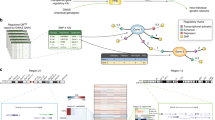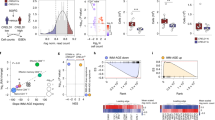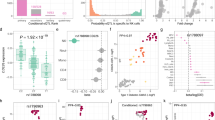Abstract
Antigen presentation to T cells by MHC molecules is essential for adaptive immune responses. To determine the exact position of a gene affecting expression of MHC molecules, we finely mapped a previously defined rat quantitative trait locus regulating MHC class II on microglia in an advanced intercross line. We identified a small interval including the gene MHC class II transactivator (Mhc2ta) and, using a map over six inbred strains combined with gene sequencing and expression analysis, two conserved Mhc2ta haplotypes segregating with MHC class II levels. In humans, a –168A → G polymorphism in the type III promoter of the MHC class II transactivator (MHC2TA) was associated with increased susceptibility to rheumatoid arthritis, multiple sclerosis and myocardial infarction, as well as lower expression of MHC2TA after stimulation of leukocytes with interferon-γ. We conclude that polymorphisms in Mhc2ta and MHC2TA result in differential MHC molecule expression and are associated with susceptibility to common complex diseases with inflammatory components.
This is a preview of subscription content, access via your institution
Access options
Subscribe to this journal
Receive 12 print issues and online access
$209.00 per year
only $17.42 per issue
Buy this article
- Purchase on Springer Link
- Instant access to full article PDF
Prices may be subject to local taxes which are calculated during checkout







Similar content being viewed by others
References
Flügel, A. et al. Migratory activity and functional changes of green fluorescent effector cells before and during experimental autoimmune encephalomyelitis. Immunity 14, 547–560 (2001).
Sedgwick, J.D., Schwender, S., Gregersen, R., Dorries, R. & ter Meulen, V. Resident macrophages (ramified microglia) of the adult brown Norway rat central nervous system are constitutively major histocompatibility complex class II positive. J. Exp. Med 177, 1145–1152 (1993).
Piehl, F. et al. Non-MHC gene regulation of nerve root injury-induced spinal cord inflammation and neuron death. J. Neuroimmunol. 101, 87–97 (1999).
Lundberg, C., Lidman, O., Holmdahl, R., Olsson, T. & Piehl, F. Neurodegeneration and glial activation patterns after mechanical nerve injury are differentially regulated by non-MHC genes in congenic inbred rat strains. J. Comp. Neurol. 431, 75–87 (2001).
Ting, J.P. & Trowsdale, J. Genetic control of MHC class II expression. Cell 109, 21–33 (2002).
Boss, J.M. & Jensen, P.E. Transcriptional regulation of the MHC class II antigen presentation pathway. Curr. Opin. Immunol. 15, 105–111 (2003).
Dahlman, I. et al. Genome-wide linkage analysis of chronic relapsing experimental autoimmune encephalomyelitis in the rat identifies a major susceptibility locus on chromosome 9. J. Immunol. 162, 2581–2588 (1999).
Lidman, O. et al. Discrete gene loci regulate neurodegeneration, lymphocyte infiltration, and major histocompatibility complex class II expression in the CNS. J. Neurosci. 23, 9817–9823 (2003).
Maehlen, J., Schroder, H., Klareskog, L., Olsson, T. & Kristensson, K. Axotomy induces MHC class I antigen expression on rat nerve cells. Neurosci. Lett. 92, 8–13 (1988).
Streit, W.J., Graeber, M.B. & Kreutzberg, G.W. Peripheral nerve lesion produces increased levels of major histocompatibility complex antigens in the central nervous system. J. Neuroimmunol. 21, 117–123 (1989).
Darvasi, A. & Soller, M. Advanced intercross lines, an experimental population for fine genetic mapping. Genetics 141, 1199–1207 (1995).
Jagodic, M. et al. An advanced intercross line resolves Eae18 into two narrow quantitative trait loci syntenic to multiple sclerosis candidate loci. J. Immunol. 173, 1366–1373 (2004).
Libby, P. Inflammation in atherosclerosis. Nature 420, 868–874 (2002).
Patarroyo, J.C. et al. Single nucleotide polymorphisms in MHC2TA, the gene encoding the MHC class II transactivator (CIITA). Genes Immun. 3, 34–37 (2002).
Steimle, V., Otten, L.A., Zufferey, M. & Mach, B. Complementation cloning of an MHC class II transactivator mutated in hereditary MHC class II deficiency (or bare lymphocyte syndrome). Cell 75, 135–146 (1993).
Chang, C.H., Guerder, S., Hong, S.C., van Ewijk, W. & Flavell, R.A. Mice lacking the MHC class II transactivator (CIITA) show tissue-specific impairment of MHC class II expression. Immunity 4, 167–178 (1996).
Chang, C.H. & Flavell, R.A. Class II transactivator regulates the expression of multiple genes involved in antigen presentation. J. Exp. Med. 181, 765–767 (1995).
Kern, I., Steimle, V., Siegrist, C.A. & Mach, B. The two novel MHC class II transactivators RFX5 and CIITA both control expression of HLA-DM genes. Int. Immunol. 7, 1295–1299 (1995).
Nagarajan, U.M., Bushey, A. & Boss, J.M. Modulation of gene expression by the MHC class II transactivator. J. Immunol. 169, 5078–5088 (2002).
Muhlethaler-Mottet, A., Otten, L.A., Steimle, V. & Mach, B. Expression of MHC class II molecules in different cellular and functional compartments is controlled by differential usage of multiple promoters of the transactivator CIITA. EMBO J. 16, 2851–2860 (1997).
Otten, L.A., Steimle, V., Bontron, S. & Mach, B. Quantitative control of MHC class II expression by the transactivator CIITA. Eur. J. Immunol. 28, 473–478 (1998).
Stüve, O. et al. The role of the MHC class II transactivator in class II expression and antigen presentation by astrocytes and in susceptibility to central nervous system autoimmune disease. J. Immunol. 169, 6720–6732 (2002).
Tompkins, S.M. et al. De novo central nervous system processing of myelin antigen is required for the initiation of experimental autoimmune encephalomyelitis. J. Immunol. 168, 4173–4183 (2002).
Baumgart, M., Moos, V., Schuhbauer, D. & Muller, B. Differential expression of major histocompatibility complex class II genes on murine macrophages associated with T cell cytokine profile and protective/suppressive effects. Proc. Natl. Acad. Sci. USA 95, 6936–6940 (1998).
Otten, L.A. et al. Deregulated MHC class II transactivator expression leads to a strong Th2 bias in CD4+ T lymphocytes. J. Immunol. 170, 1150–1157 (2003).
Hegde, N.R., Chevalier, M.S. & Johnson, D.C. Viral inhibition of MHC class II antigen presentation. Trends Immunol. 24, 278–285 (2003).
Ueda, H. et al. Association of the T-cell regulatory gene CTLA4 with susceptibility to autoimmune disease. Nature 423, 506–511 (2003).
Sartoris, S. et al. Analysis of CIITA encoding AIR-1 gene promoters in insulin-dependent diabetes mellitus and rheumatoid arthritis patients from the northeast of Italy: absence of sequence variability. Hum. Immunol. 61, 599–604 (2000).
Janitz, M., Reiners-Schramm, L., Muhlethaler-Mottet, A., Rosowski, M. & Lauster, R. Analysis of the sequence polymorphism within class II transactivator gene promoters. Exp. Clin. Immunogenet. 18, 199–205 (2001).
Rasmussen, H.B., Kelly, M.A. & Clausen, J. Genetic susceptibility to multiple sclerosis: detection of polymorphic nucleotides and an intron in the 3′ untranslated region of the major histocompatibility complex class II transactivator gene. Hum. Immunol. 62, 371–377 (2001).
Hammarberg, H. et al. Neuroprotection by encephalomyelitis: rescue of mechanically injured neurons and neurotrophin production by CNS-infiltrating T and natural killer cells. J. Neurosci. 20, 5283–5291 (2000).
Olsson, T., Lidman, O. & Piehl, F. Harm or heal - divergent effects of autoimmune neuroinflammation? Trends Immunol. 24, 5–6 (2003).
Cao, D. et al. Isolation and functional characterization of regulatory CD25brightCD4+ T cells from the target organ of patients with rheumatoid arthritis. Eur. J. Immunol. 33, 215–223 (2003).
Mallat, Z. et al. Induction of a regulatory T cell type 1 response reduces the development of atherosclerosis in apolipoprotein E-knockout mice. Circulation 108, 1232–1237 (2003).
Turesson, C., Jarenros, A. & Jacobsson, L. Increased incidence of cardiovascular disease in patients with rheumatoid arthritis: results from a community based study. Ann. Rheum. Dis. 63, 952–955 (2004).
Kwak, B., Mulhaupt, F., Myit, S. & Mach, F. Statins as a newly recognized type of immunomodulator. Nat. Med. 6, 1399–1402 (2000).
Youssef, S. et al. The HMG-CoA reductase inhibitor, atorvastatin, promotes a Th2 bias and reverses paralysis in central nervous system autoimmune disease. Nature 420, 78–84 (2002).
Padyukov, L.C.S., Stolt, P., Alfredsson, L. & Klareskog, L. The EIRA study group. A gene-environment interaction between smoking and shared epitope genes in HLA-DRB1 provides a high risk of seropositive rheumatoid arthritis. Arthritis Rheum. 50, 3085–3092 (2004).
Khademi, M. et al. T Cell Ig- and mucin-domain-containing molecule-3 (TIM-3) and TIM-1 molecules are differentially expressed on human Th1 and Th2 cells and in cerebrospinal fluid-derived mononuclear cells in multiple sclerosis. J. Immunol. 172, 7169–7176 (2004).
Lander, E.S. et al. MAPMAKER: an interactive computer package for constructing primary genetic linkage maps of experimental and natural populations. Genomics 1, 174–181 (1987).
Lander, E.S. & Botstein, D. Mapping mendelian factors underlying quantitative traits using RFLP linkage maps. Genetics 121, 185–199 (1989).
Schneider, S., Roessli, D. & Excoffier, L. Arlequin ver. 2000: A Software for Population Genetics Data Analysis (Genetics and Biometrics Laboratory, University of Geneva, Switzerland, 2000).
Stephens, M. & Donnelly, P. A comparison of bayesian methods for haplotype reconstruction from population genotype data. Am. J. Hum. Genet. 73, 1162–1169 (2003).
McDonald, W.I. et al. Recommended diagnostic criteria for multiple sclerosis: guidelines from the International Panel on the diagnosis of multiple sclerosis. Ann. Neurol. 50, 121–127 (2001).
Arnett, F.C. et al. The American Rheumatism Association 1987 revised criteria for the classification of rheumatoid arthritis. Arthritis Rheum. 31, 315–324 (1988).
Stolt, P. et al. Quantification of the influence of cigarette smoking on rheumatoid arthritis: results from a population based case-control study, using incident cases. Ann. Rheum. Dis. 62, 835–841 (2003).
Eriksson, P. et al. Human evidence that the cystatin C gene is implicated in focal progression of coronary artery disease. Arterioscler. Thromb. Vasc. Biol. 24, 551–557 (2004).
Jobs, M., Howell, W.M., Strömqvist, L., Mayr, T. & Brookes, A.J. DASH-2 flexible, low-cost, and high-throughput SNP genotyping by dynamic allele-specific hybridization on membrane arrays. Genome Res. 13, 916–924 (2003).
Jurinke, C., van den Boom, D., Cantor, C.R. & Koster, H. Automated genotyping using the DNA MassArray technology. Methods Mol. Biol. 187, 179–192 (2002).
Acknowledgements
L.P., P.E. and E.Å. contributed equally to the human genetic part of the study. We thank K. Becanovic, J. Lorentzen, L. Bäckdahl and E. Wallström for expert advice in genetics and practical help with breeding of the AIL; K. Duvefelt for collaboration on microarray analysis; and the EIRA group, E. Jemseby, the MI group and B. Burt for their contributions. This study was supported by grants from the Wadsworth Foundation, Torsten and Ragnar Söderbergs Foundation, The Swedish Heart-Lung Foundation, the Petrus and Augusta Hedlunds Foundation, Björklunds Foundation, Nils and Bibbi Jenssens Foundation, the Swedish Foundation for Neurologically Disabled, Montel Williams Foundation, Svenska Läkaresällskapet, Max and Edit Follins Foundation, the King Gustaf V and Queen Victoria foundation, AFA insurance and the Swedish Research Council, af Ugglas Foundation, Novartis Foundation, Royal Physiographic Society and The Swedish Medical Research Council.
Author information
Authors and Affiliations
Corresponding author
Ethics declarations
Competing interests
The authors declare no competing financial interests.
Supplementary information
Supplementary Table 1
Genotype and allele frequencies for SNP2 (rs2229320plus27bp) and SNP3 (rs4774). (PDF 57 kb)
Supplementary Table 2
Primers and probes used for RT-PCR. (XLS 20 kb)
Rights and permissions
About this article
Cite this article
Swanberg, M., Lidman, O., Padyukov, L. et al. MHC2TA is associated with differential MHC molecule expression and susceptibility to rheumatoid arthritis, multiple sclerosis and myocardial infarction. Nat Genet 37, 486–494 (2005). https://doi.org/10.1038/ng1544
Received:
Accepted:
Published:
Issue Date:
DOI: https://doi.org/10.1038/ng1544
This article is cited by
-
Association of CIITA (rs8048002) and CLEC2D (rs2114870) gene variants and type 1 diabetes mellitus
Journal of Diabetes & Metabolic Disorders (2024)
-
Does epigenetic markers of HLA gene show association with coronary artery disease in Indian subjects?
Molecular Biology Reports (2024)
-
Differential expression of the inflammatory ciita gene may be accompanied by altered bone properties in intact sex steroid-deficient female rats
BMC Research Notes (2023)
-
The NLR gene family: from discovery to present day
Nature Reviews Immunology (2023)
-
Advances in nanotechnology versus stem cell therapy for the theranostics of multiple sclerosis disease
Applied Nanoscience (2023)



